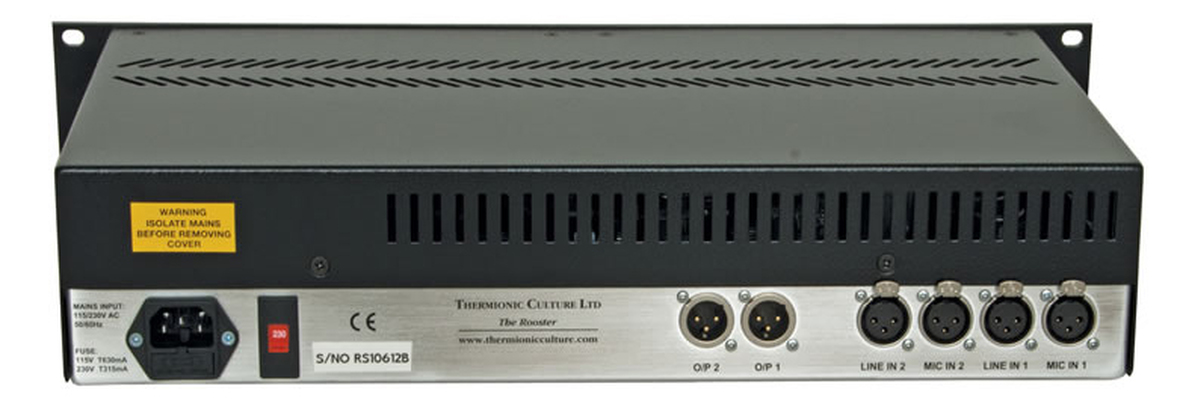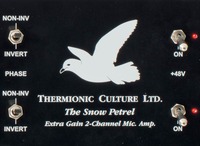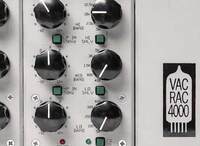
Review by George Shilling
Subtitled “Valve pre-amp with EQ & attitude”, The Rooster continues the series of bold, mildly eccentric, all valve, proudly English outboard from the workshop of the legendary Vic Keary, with partner Jonathan Bailes looking after front panel design, manual writing and so on. The Rooster appears to build upon the reputation of earlier units and indeed combines certain features borrowed from several of these.
Essentially, the unit comprises two channels, with high quality microphone preamps, separate line inputs and DI inputs, some powerful ‘vari slope’ EQ (similar principle to the Earlybird 2 EQ), and the Attitude section which features the same 5725 distortion valve as featured in the much-loved Culture Vulture Mastering unit.
Front panel layout is perhaps a little cluttered and idiosyncratic, but the switchgear all works solidly. Labelling is clear, but a bit more colour (other than the two red ‘chicken head’ knobs) might have been helpful. The channels are laid out from left to right, one set of controls above the other. Preamp and input controls are situated to the left. Firstly there are useful Phase Invert toggle switches, followed by Mic/Line selection. These inputs have the luxury of discrete XLR connectors on the rear of the unit, so there is no danger of sending 48v to line connections. Next along are the DI jack sockets. These override the selection toggle when a plug is inserted. The input gain knobs are smoothly damped and uncalibrated – just the old Spinal Tap 1 to 11 scale. With no graphical delineation between the sections we next start to encounter EQ controls, but also relevant to inputs are the phantom power toggles which, oddly, are located across the other side, last before the power toggle and blinding green power lamp. No illuminating indication is provided for phantom, but they are locking toggles which affords some protection against accidental operation.
Meanwhile, back at the EQ, the first section is a fixed frequency Bass Lift scaled 0 to 10. At small boosts (around 3) this acts as a shelving curve, applying about 4dB of boost from 400Hz downwards, but as more is applied the low end ‘tips up’ so at full tilt the graph looks almost diagonal from 1dB boost at 1kHz down to an 18dB boost at 30Hz. The Mid/Hi Lift is even more versatile, accompanied by a three position toggle selecting 2.5k, 4k or ‘Hi’. These are all rather broad curves, while the Hi setting does the vari slope thing again, with full tilt giving a 10kHz-centred boost. Mid Cut is next with a centre frequency of 700Hz and a narrowing bell-curve as Cut is increased. Bass Cut is a six position switched knob with a complex selection of different filtering and shelving settings, the details of which I won’t bore you with, suffice to say they cover most filtering requirements from simply extracting the very low stuff, to a shelving curve that is 3dB down at 3kHz (and 10dB down at 30Hz). Most settings drop away more steeply at very low frequencies.

Next along is a switchable Low Pass Filter (-6dB at 8kHz). This is actually plumbed in after the distortion circuit, in order to tame and smooth excessive fuzz when pushing the Attitude section. And so to the distortion section. A toggle selects Triode (for smoother 2nd order harmonic distortion) or Pentode (for grungier 3rd order harmonics). The red ‘rooster’ Attitude knob has six positions – 1 to 5 then ‘Max’. In position 1 the signal can be very clean indeed (typically 0.01% claimed, but only 48dB mic gain available). As the setting is increased, the graunch increases. Of course, this is all rather dependent on the input source signal, and also the input gain applied, so judicious tweaking and experimentation is required. Finally, the output level knob works as expected, this can also be brought into play to reduce overdriven signals, to avoid overloading the next piece of equipment in the chain.
The basic character of the mic amp is big and commanding, without sounding coloured. There is a lovely richness evident on vocals through a condenser. Increasing the Attitude setting needs careful attention and juggling also of the Input and Output Gains, but a wide range of distortion amount is available, and it sounds great – rich, juicy and unmistakeably valvey. The Attitude settings are of course inextricably linked to and reliant on input signal level and Input knob setting, suffice to say that the six positions will take you to where you need to be in all instances, from clean through mild warming to total fuzz. For drum ambience, crushing with plenty of Pentode is tremendous, lending a trashy excitement to the sound. Subtle Triode distortion can be usefully employed to enhance ordinary sounding signals including vocals, or even whole mixes. Cello sounded gorgeously warm and rich, using a U87 and an fair amount of distortion (Triode, 3), with just a bit of Hi EQ required to poke it through the mix.
The EQ bands work amazingly well, you feel like you are adjusting a radiogramme tone control, such is the powerful nature of these. Just occasionally you’ll miss being able to notch out a narrow band, in which case another device will be needed. Being so coarse, and with continuous knobs smoothly damped, the EQ is quick to set, the only operational problem I found was the lack of any bypass switches – I found myself winding knobs in and out to hear what they were doing. Flipping the LPF in certainly sweetens the tone when large amounts of distortion are applied, I would perhaps have liked a more variable circuit for this aspect. As suggested in the clear manual this can be especially useful for DI signals such as bass guitar - which sounds wonderfully vibrant, even set clean and flat.
The build of the unit is excellent, it feels solid and weighty and appears to have been built to last. To cram all the character and versatility of The Rooster into a 2U and then make it a dual channel device is remarkable – the price seems quite a bargain. And to have the separate Line inputs is a real bonus – if you aren’t brave enough to commit to recording with distortion, running the signal back through for re-recording or on mixdown is always simple to set up. And even if you only occasionally venture away from clean, with such solid sounding mic amps and characterful EQ sections, the Rooster would make a great main recording channel for any studio.
Pros: Culture Vulture style distortion; Great mic preamps; Uniquely characterful EQ; All valve
Cons: No EQ bypass
Reproduced with kind permission from www.georgeshilling.com. Copyright ©





